Java8 新特性
- 速度更快
- 代码更少(增加了新的语法Lambda 表达式)
- 强大的Stream API便于并行
- 最大化减少空指针异常Optional
- 其中最为核心的为Lambda 表达式与Stream API
Lambda表达式
Lambda 是一个匿名函数,我们可以把Lambda表达式理解为是一段可以传递的代码(将代码像数据一样进行传递)。可以写出更简洁、更灵活的代码。作为一种更紧凑的代码风格,使Java的语言表达能力得到了提升。
public class TestLambda1 {
//原来的匿名内部类
@Test
public void test1(){
Comparator<String> com = new Comparator<String>(){
@Override
public int compare(String o1, String o2) {
return Integer.compare(o1.length(), o2.length());
}
};
TreeSet<String> ts = new TreeSet<>(com);
TreeSet<String> ts2 = new TreeSet<>(new Comparator<String>(){
@Override
public int compare(String o1, String o2) {
return Integer.compare(o1.length(), o2.length());
}
});
}
//现在的 Lambda 表达式
@Test
public void test2(){
Comparator<String> com = (x, y) -> Integer.compare(x.length(), y.length());
TreeSet<String> ts = new TreeSet<>(com);
}
List<Employee> emps = Arrays.asList(
new Employee(101, "张三", 18, 9999.99),
new Employee(102, "李四", 59, 6666.66),
new Employee(103, "王五", 28, 3333.33),
new Employee(104, "赵六", 8, 7777.77),
new Employee(105, "田七", 38, 5555.55)
);
//需求:获取公司中年龄小于 35 的员工信息
public List<Employee> filterEmployeeAge(List<Employee> emps){
List<Employee> list = new ArrayList<>();
for (Employee emp : emps) {
if(emp.getAge() <= 35){
list.add(emp);
}
}
return list;
}
@Test
public void test3(){
List<Employee> list = filterEmployeeAge(emps);
for (Employee employee : list) {
System.out.println(employee);
}
}
//需求:获取公司中工资大于 5000 的员工信息
public List<Employee> filterEmployeeSalary(List<Employee> emps){
List<Employee> list = new ArrayList<>();
for (Employee emp : emps) {
if(emp.getSalary() >= 5000){
list.add(emp);
}
}
return list;
}
//优化方式一:策略设计模式
public List<Employee> filterEmployee(List<Employee> emps, MyPredicate<Employee> mp){
List<Employee> list = new ArrayList<>();
for (Employee employee : emps) {
if(mp.test(employee)){
list.add(employee);
}
}
return list;
}
@Test
public void test4(){
List<Employee> list = filterEmployee(emps, new FilterEmployeeForAge());
for (Employee employee : list) {
System.out.println(employee);
}
System.out.println("------------------------------------------");
List<Employee> list2 = filterEmployee(emps, new FilterEmployeeForSalary());
for (Employee employee : list2) {
System.out.println(employee);
}
}
//优化方式二:匿名内部类
@Test
public void test5(){
List<Employee> list = filterEmployee(emps, new MyPredicate<Employee>() {
@Override
public boolean test(Employee t) {
return t.getId() <= 103;
}
});
for (Employee employee : list) {
System.out.println(employee);
}
}
//优化方式三:Lambda 表达式
@Test
public void test6(){
List<Employee> list = filterEmployee(emps, (e) -> e.getAge() <= 35);
list.forEach(System.out::println);
System.out.println("------------------------------------------");
List<Employee> list2 = filterEmployee(emps, (e) -> e.getSalary() >= 5000);
list2.forEach(System.out::println);
}
//优化方式四:Stream API
@Test
public void test7(){
emps.stream()
.filter((e) -> e.getAge() <= 35)
.forEach(System.out::println);
System.out.println("----------------------------------------------");
emps.stream()
.map(Employee::getName)
.limit(3)
.sorted()
.forEach(System.out::println);
}
}
复制代码
/*
* 一、Lambda 表达式的基础语法:Java8中引入了一个新的操作符 "->" 该操作符称为箭头操作符或 Lambda 操作符
* 箭头操作符将 Lambda 表达式拆分成两部分:
*
* 左侧:Lambda 表达式的参数列表
* 右侧:Lambda 表达式中所需执行的功能, 即 Lambda 体
*
* 语法格式一:无参数,无返回值
* () -> System.out.println("Hello Lambda!")
*
* 语法格式二:有一个参数,并且无返回值
* (x) -> System.out.println(x)
*
* 语法格式三:若只有一个参数,小括号可以省略不写
* x -> System.out.println(x)
*
* 语法格式四:有两个以上的参数,有返回值,并且 Lambda 体中有多条语句
* Comparator<Integer> com = (x, y) -> {
* System.out.println("函数式接口");
* return Integer.compare(x, y);
* };
*
* 语法格式五:若 Lambda 体中只有一条语句, return 和 大括号都可以省略不写
* Comparator<Integer> com = (x, y) -> Integer.compare(x, y);
*
* 语法格式六:Lambda 表达式的参数列表的数据类型可以省略不写,因为JVM编译器通过上下文推断出,数据类型,即“类型推断”
* (Integer x, Integer y) -> Integer.compare(x, y);
*
*
* 二、Lambda 表达式需要“函数式接口”的支持
*只包含一个抽象方法的接口,称为函数式接口。你可以通过 Lambda *表达式来创建该接口的对象。(若 Lambda
*表达式抛出一个受检异常,那么该异常需要在目标接口的抽象方
*法上进行声明)。
*我们可以在任意函数式接口上使用 @FunctionalInterface 注解,
*这样做可以检查它是否是一个函数式接口,同时 javadoc 也会包 *含一条声明,说明这个接口是一个函数式接口。
*作为参数传递 Lambda 表达式:为了将 Lambda 表达式作为参数传递,接收Lambda *表达式的参数类型必须是与该 Lambda 表达式兼容的函数式接口的类型。
*/
public class TestLambda2 {
@Test
public void test1(){
int num = 0;//jdk 1.7 前,必须是 final
Runnable r = new Runnable() {
@Override
public void run() {
System.out.println("Hello World!" + num);
}
};
r.run();
System.out.println("-------------------------------");
Runnable r1 = () -> System.out.println("Hello Lambda!");
r1.run();
}
@Test
public void test2(){
Consumer<String> con = x -> System.out.println(x);
con.accept("hello world!");
}
@Test
public void test3(){
Comparator<Integer> com = (x, y) -> {
System.out.println("函数式接口");
return Integer.compare(x, y);
};
}
@Test
public void test4(){
Comparator<Integer> com = (x, y) -> Integer.compare(x, y);
}
@Test
public void test5(){
// String[] strs;
// strs = {"aaa", "bbb", "ccc"};
List<String> list = new ArrayList<>();
show(new HashMap<>());
}
public void show(Map<String, Integer> map){
}
//需求:对一个数进行运算
@Test
public void test6(){
Integer num = operation(100, (x) -> x * x);
System.out.println(num);
System.out.println(operation(200, (y) -> y + 200));
}
public Integer operation(Integer num, MyFun mf){
return mf.getValue(num);
}
}
复制代码
@FunctionalInterface
public interface MyFun {
public Integer getValue(Integer num);
}
复制代码
函数式接口
java内置的四大核心函数式接口

其他接口
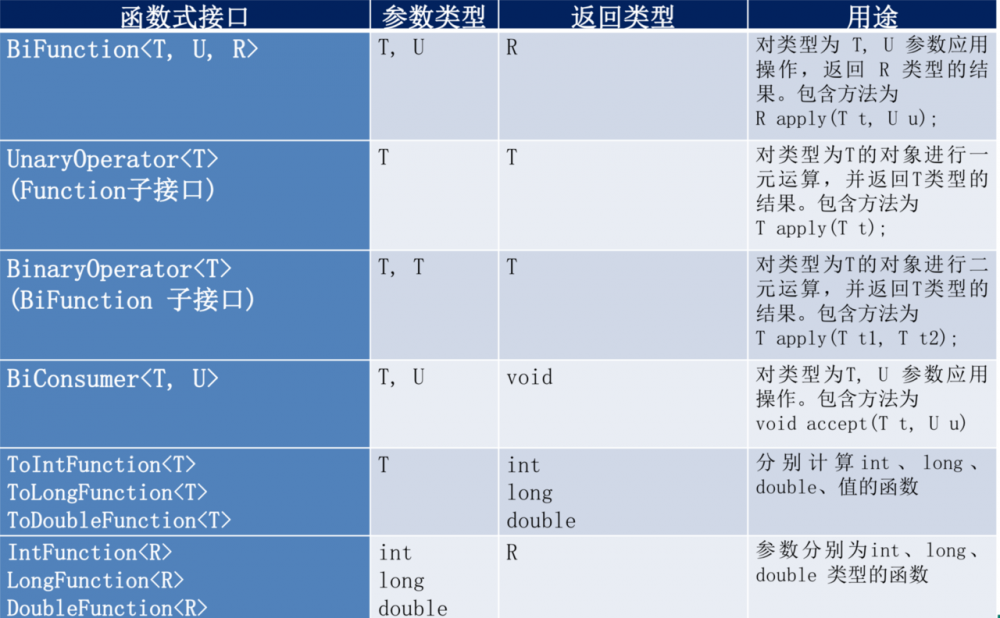
/*
* Java8 内置的四大核心函数式接口
*
* Consumer<T> : 消费型接口
* void accept(T t);
*
* Supplier<T> : 供给型接口
* T get();
*
* Function<T, R> : 函数型接口
* R apply(T t);
*
* Predicate<T> : 断言型接口
* boolean test(T t);
*
*/
public class TestLambda3 {
//Predicate<T> 断言型接口:
@Test
public void test4(){
List<String> list = Arrays.asList("Hello", "stream", "Lambda", "www", "ok");
List<String> strList = filterStr(list, (s) -> s.length() > 3);
for (String str : strList) {
System.out.println(str);
}
}
//需求:将满足条件的字符串,放入集合中
public List<String> filterStr(List<String> list, Predicate<String> pre){
List<String> strList = new ArrayList<>();
for (String str : list) {
if(pre.test(str)){
strList.add(str);
}
}
return strList;
}
//Function<T, R> 函数型接口:
@Test
public void test3(){
String newStr = strHandler("/t/t/t JAVA是世界上最好的语言 ", (str) -> str.trim());
System.out.println(newStr);
String subStr = strHandler("JAVA是世界上最好的语言", (str) -> str.substring(2, 5));
System.out.println(subStr);
}
//需求:用于处理字符串
public String strHandler(String str, Function<String, String> fun){
return fun.apply(str);
}
//Supplier<T> 供给型接口 :
@Test
public void test2(){
List<Integer> numList = getNumList(10, () -> (int)(Math.random() * 100));
for (Integer num : numList) {
System.out.println(num);
}
}
//需求:产生指定个数的整数,并放入集合中
public List<Integer> getNumList(int num, Supplier<Integer> sup){
List<Integer> list = new ArrayList<>();
for (int i = 0; i < num; i++) {
Integer n = sup.get();
list.add(n);
}
return list;
}
//Consumer<T> 消费型接口 :
@Test
public void test1(){
happy(10000, (m) -> System.out.println("淘宝购物,每次消费:" + m + "元"));
}
public void happy(double money, Consumer<Double> con){
con.accept(money);
}
}
复制代码
方法引用
当要传递给Lambda体的操作,已经有实现的方法了,可以使用方法引用! (实现抽象方法的参数列表,必须与方法引用方法的参数列表保持一致!) 方法引用:使用操作符 “::” 将方法名和对象或类的名字分隔开来。 复制代码
/*
* 一、方法引用:若 Lambda 体中的功能,已经有方法提供了实现,可以使用方法引用
* (可以将方法引用理解为 Lambda 表达式的另外一种表现形式)
*
* 1. 对象的引用 :: 实例方法名
*
* 2. 类名 :: 静态方法名
*
* 3. 类名 :: 实例方法名
*
* 注意:
* ①方法引用所引用的方法的参数列表与返回值类型,需要与函数式接口中抽象方法的参数列表和返回值类型保持一致!
* ②若Lambda 的参数列表的第一个参数,是实例方法的调用者,第二个参数(或无参)是实例方法的参数时,格式: ClassName::MethodName
*/
public class TestMethodRef {
//类名 :: 实例方法名
@Test
public void test5(){
BiPredicate<String, String> bp = (x, y) -> x.equals(y);
System.out.println(bp.test("abcde", "abcde"));
System.out.println("-----------------------------------------");
BiPredicate<String, String> bp2 = String::equals;
System.out.println(bp2.test("abc", "abc"));
System.out.println("-----------------------------------------");
Function<Employee, String> fun = (e) -> e.show();
System.out.println(fun.apply(new Employee()));
System.out.println("-----------------------------------------");
Function<Employee, String> fun2 = Employee::show;
System.out.println(fun2.apply(new Employee()));
}
//类名 :: 静态方法名
@Test
public void test4(){
Comparator<Integer> com = (x, y) -> Integer.compare(x, y);
System.out.println("-------------------------------------");
Comparator<Integer> com2 = Integer::compare;
}
@Test
public void test3(){
BiFunction<Double, Double, Double> fun = (x, y) -> Math.max(x, y);
System.out.println(fun.apply(1.5, 22.2));
System.out.println("--------------------------------------------------");
BiFunction<Double, Double, Double> fun2 = Math::max;
System.out.println(fun2.apply(1.2, 1.5));
}
//对象的引用 :: 实例方法名
@Test
public void test2(){
Employee emp = new Employee(101, "张三", 18, 9999.99);
Supplier<String> sup = () -> emp.getName();
System.out.println(sup.get());
System.out.println("----------------------------------");
Supplier<String> sup2 = emp::getName;
System.out.println(sup2.get());
}
@Test
public void test1(){
PrintStream ps = System.out;
Consumer<String> con = (str) -> ps.println(str);
con.accept("Hello World!");
System.out.println("--------------------------------");
Consumer<String> con2 = ps::println;
con2.accept("Hello Java8!");
Consumer<String> con3 = System.out::println;
}
}
复制代码
构造器引用
格式: ClassName::new 与函数式接口相结合,自动与函数式接口中方法兼容。 可以把构造器引用赋值给定义的方法,与构造器参数。构造器的参数列表,需要与函数式接口中参数列表保持一致
//构造器引用
@Test
public void test7(){
Function<String, Employee> fun = Employee::new;
BiFunction<String, Integer, Employee> fun2 = Employee::new;
}
@Test
public void test6(){
Supplier<Employee> sup = () -> new Employee();
System.out.println(sup.get());
System.out.println("------------------------------------");
Supplier<Employee> sup2 = Employee::new;
System.out.println(sup2.get());
}
复制代码
数组引用
类型[] :: new;
//数组引用
@Test
public void test8(){
Function<Integer, String[]> fun = (args) -> new String[args];
String[] strs = fun.apply(10);
System.out.println(strs.length);
System.out.println("--------------------------");
Function<Integer, Employee[]> fun2 = Employee[] :: new;
Employee[] emps = fun2.apply(20);
System.out.println(emps.length);
}
复制代码
Stream API
Java8中有两大最为重要的改变。第一个是 Lambda 表达式;另外一 个则是 Stream API(java.util.stream.*)。 Stream 是 Java8 中处理集合的关键抽象概念,它可以指定你希望对 集合进行的操作,可以执行非常复杂的查找、过滤和映射数据等操作。 使用Stream API 对集合数据进行操作,就类似于使用 SQL 执行的数据库查询。也可以使用 Stream API 来并行执行操作。简而言之, Stream API 提供了一种高效且易于使用的处理数据的方式。
什么是Stream
Stream:数据渠道,用于操作数据源(集合、数组等)所生成的元素序列。 “集合讲的是数据,流讲的是计算!” 注意:
- Stream 自己不会存储元素。
- Stream 不会改变源对象。相反,他们会返回一个持有结果的新Stream。
- Stream 操作是延迟执行的。这意味着他们会等到需要结果的时候才执行。
Stream 操作的三个步骤
- 创建 Stream。 一个数据源(如:集合、数组),获取一个流
- 中间操作。一个中间操作链,对数据源的数据进行处理。
- 终止操作(终端操作)。一个终止操作,执行中间操作链,并产生结果

1.创建Steam
1.1 Java8 中的 Collection 接口被扩展,提供了两个获取流的方法:
- default Stream stream() : 返回一个顺序流
- default Stream parallelStream() : 返回一个并行流
1.2 由数组创建Stream。Java8 中的 Arrays 的静态方法 stream() 可 以获取数组流:
- static Stream stream(T[] array): 返回一个流
重载形式,能够处理对应基本类型的数组:
- public static IntStream stream(int[] array)
- public static LongStream stream(long[] array)
- public static DoubleStream stream(double[] array)
1.3 由值创建Stream 可以使用静态方法 Stream.of(), 通过显示值,创建一个流。他可以接收任意数量的参数。
- public static Stream of(T... values) : 返回一个流
1.4 由函数创建流:创建无限流
可以使用静态方法 Stream.iterate() 和 Stream.generate(), 创建无限流。
- 迭代 public static Stream iterate(final T seed, final UnaryOperator f)
- 生成 public static Stream generate(Supplier s)
2.Steam的中间操作
多个中间操作可以连接起来形成一个流水线,除非流水 线上触发终止操作,否则中间操作不会执行任何的处理! 而在终止操作时一次性全部处理,称为“惰性求值”。
- 2.1 筛选与切片

- 2.2 映射
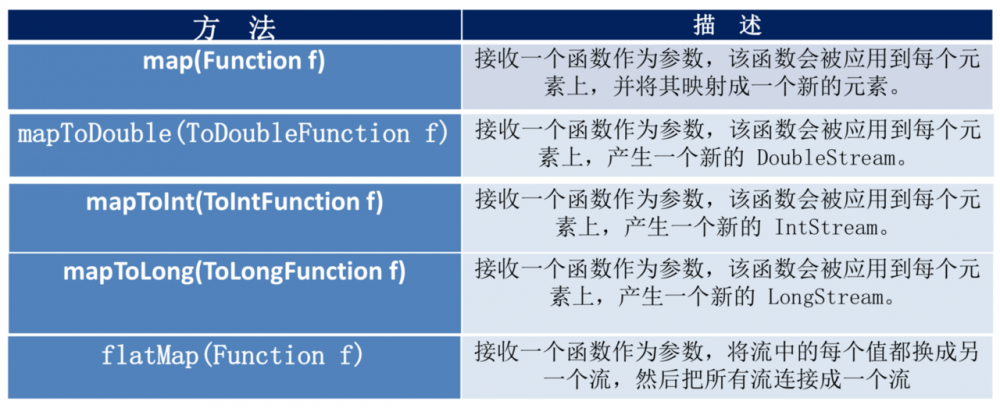
- 2.3 排序

Steam 的终止操作
- 3.1 查找与匹配 终端操作会从流的流水线生成结果。其结果可以是任何不是流的 值,例如:List、Integer,甚至是 void 。
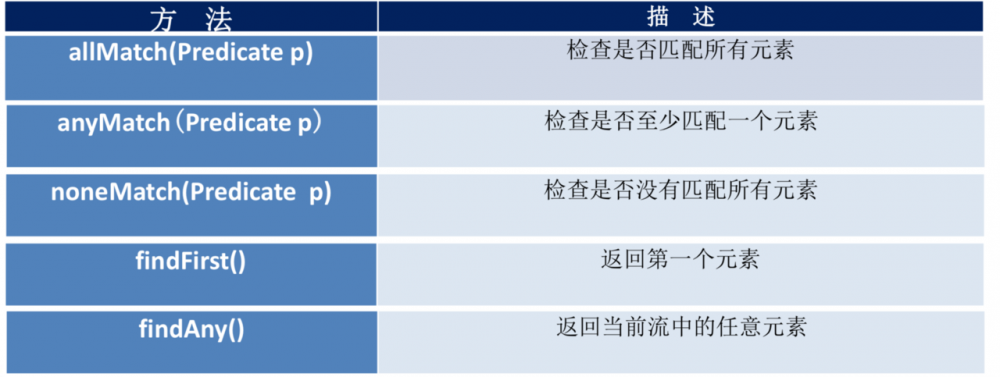
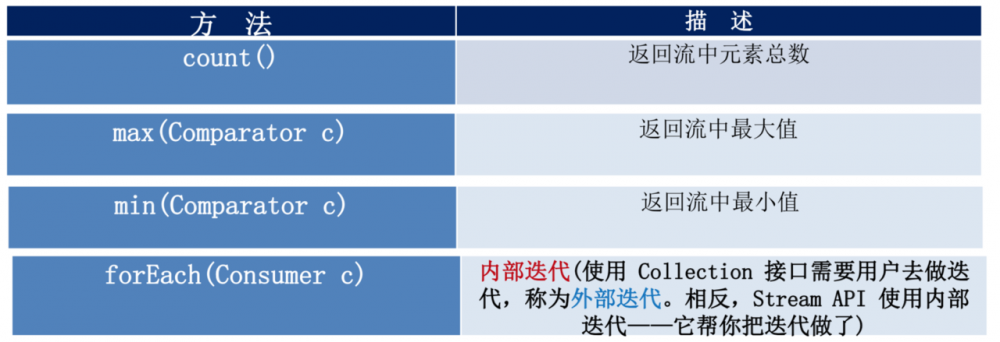
- 3.2 归约

:map 和 reduce 的连接通常称为 map-reduce 模式,因 Google 用它 来进行网络搜索而出名。
- 3.3 收集

Collector 接口中方法的实现决定了如何对流执行收集操作(如收 集到 List、Set、Map)。但是 Collectors 实用类提供了很多静态 方法,可以方便地创建常见收集器实例,具体方法与实例如下表:
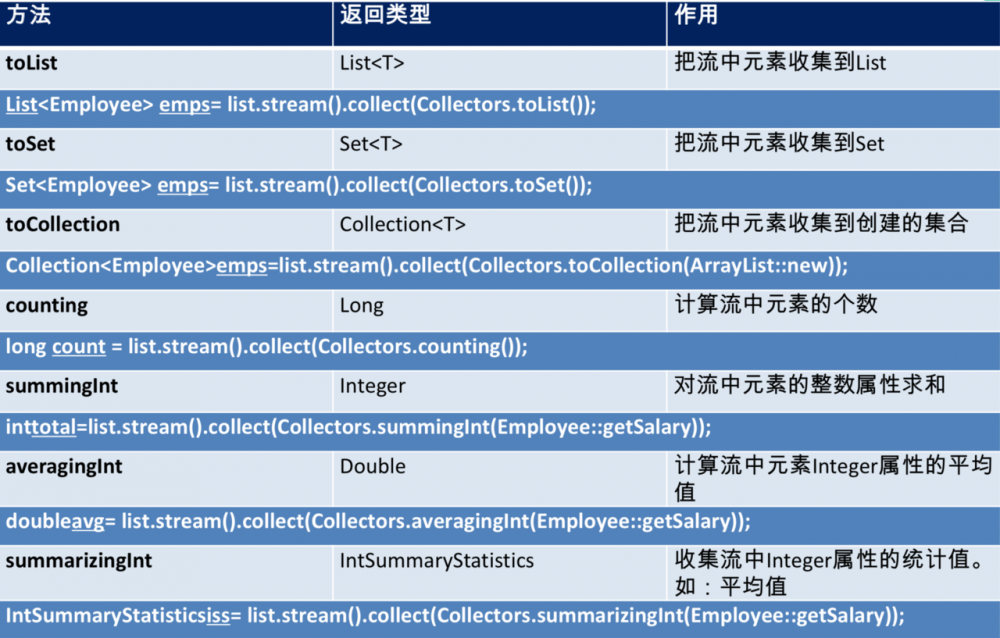

/*
* 一、Stream API 的操作步骤:
*
* 1. 创建 Stream
*
* 2. 中间操作
*
* 3. 终止操作(终端操作)
*/
public class TestStreamaAPI {
//1. 创建 Stream
@Test
public void test1(){
//1. Collection 提供了两个方法 stream() 与 parallelStream()
List<String> list = new ArrayList<>();
//获取一个顺序流
Stream<String> stream = list.stream();
//获取一个并行流
Stream<String> parallelStream = list.parallelStream();
//2. 通过 Arrays 中的 stream() 获取一个数组流
Integer[] nums = new Integer[10];
Stream<Integer> stream1 = Arrays.stream(nums);
//3. 通过 Stream 类中静态方法 of()
Stream<Integer> stream2 = Stream.of(1,2,3,4,5,6);
//4. 创建无限流
//迭代
Stream<Integer> stream3 = Stream.iterate(0, (x) -> x + 2).limit(10);
stream3.forEach(System.out::println);
//生成
Stream<Double> stream4 = Stream.generate(Math::random).limit(2);
stream4.forEach(System.out::println);
}
//2. 中间操作
List<Employee> emps = Arrays.asList(
new Employee(102, "李四", 59, 6666.66),
new Employee(101, "张三", 18, 9999.99),
new Employee(103, "王五", 28, 3333.33),
new Employee(104, "赵六", 8, 7777.77),
new Employee(104, "赵六", 8, 7777.77),
new Employee(104, "赵六", 8, 7777.77),
new Employee(105, "田七", 38, 5555.55)
);
/*
筛选与切片
filter——接收 Lambda , 从流中排除某些元素。
limit——截断流,使其元素不超过给定数量。
skip(n) —— 跳过元素,返回一个扔掉了前 n 个元素的流。若流中元素不足 n 个,则返回一个空流。与 limit(n) 互补
distinct——筛选,通过流所生成元素的 hashCode() 和 equals() 去除重复元素
*/
//内部迭代:迭代操作 Stream API 内部完成
@Test
public void test2(){
//所有的中间操作不会做任何的处理
Stream<Employee> stream = emps.stream()
.filter((e) -> {
System.out.println("测试中间操作");
return e.getAge() <= 35;
});
//只有当做终止操作时,所有的中间操作会一次性的全部执行,称为“惰性求值”
stream.forEach(System.out::println);
}
//外部迭代
@Test
public void test3(){
Iterator<Employee> it = emps.iterator();
while(it.hasNext()){
System.out.println(it.next());
}
}
@Test
public void test4(){
emps.stream()
.filter((e) -> {
System.out.println("短路!"); // && ||
return e.getSalary() >= 5000;
}).limit(3)
.forEach(System.out::println);
}
@Test
public void test5(){
emps.parallelStream()
.filter((e) -> e.getSalary() >= 5000)
.skip(2)
.forEach(System.out::println);
}
@Test
public void test6(){
emps.stream()
.distinct()
.forEach(System.out::println);
}
}
复制代码
/*
* 一、 Stream 的操作步骤
*
* 1. 创建 Stream
*
* 2. 中间操作
*
* 3. 终止操作
*/
public class TestStreamAPI1 {
List<Employee> emps = Arrays.asList(
new Employee(102, "李四", 59, 6666.66),
new Employee(101, "张三", 18, 9999.99),
new Employee(103, "王五", 28, 3333.33),
new Employee(104, "赵六", 8, 7777.77),
new Employee(104, "赵六", 8, 7777.77),
new Employee(104, "赵六", 8, 7777.77),
new Employee(105, "田七", 38, 5555.55)
);
//2. 中间操作
/*
映射
map——接收 Lambda , 将元素转换成其他形式或提取信息。接收一个函数作为参数,该函数会被应用到每个元素上,并将其映射成一个新的元素。
flatMap——接收一个函数作为参数,将流中的每个值都换成另一个流,然后把所有流连接成一个流
*/
@Test
public void test1(){
Stream<String> str = emps.stream()
.map((e) -> e.getName());
System.out.println("-------------------------------------------");
List<String> strList = Arrays.asList("aaa", "bbb", "ccc", "ddd", "eee");
Stream<String> stream = strList.stream()
.map(String::toUpperCase);
stream.forEach(System.out::println);
Stream<Stream<Character>> stream2 = strList.stream()
.map(TestStreamAPI1::filterCharacter);
stream2.forEach((sm) -> {
sm.forEach(System.out::println);
});
System.out.println("---------------------------------------------");
Stream<Character> stream3 = strList.stream()
.flatMap(TestStreamAPI1::filterCharacter);
stream3.forEach(System.out::println);
}
public static Stream<Character> filterCharacter(String str){
List<Character> list = new ArrayList<>();
for (Character ch : str.toCharArray()) {
list.add(ch);
}
return list.stream();
}
/*
sorted()——自然排序
sorted(Comparator com)——定制排序
*/
@Test
public void test2(){
emps.stream()
.map(Employee::getName)
.sorted()
.forEach(System.out::println);
System.out.println("------------------------------------");
emps.stream()
.sorted((x, y) -> {
if(x.getAge() == y.getAge()){
return x.getName().compareTo(y.getName());
}else{
return Integer.compare(x.getAge(), y.getAge());
}
}).forEach(System.out::println);
}
}
复制代码
/*
* 一、 Stream 的操作步骤
*
* 1. 创建 Stream
*
* 2. 中间操作
*
* 3. 终止操作
*/
public class TestStreamAPI1 {
List<Employee> emps = Arrays.asList(
new Employee(102, "李四", 59, 6666.66),
new Employee(101, "张三", 18, 9999.99),
new Employee(103, "王五", 28, 3333.33),
new Employee(104, "赵六", 8, 7777.77),
new Employee(104, "赵六", 8, 7777.77),
new Employee(104, "赵六", 8, 7777.77),
new Employee(105, "田七", 38, 5555.55)
);
//2. 中间操作
/*
映射
map——接收 Lambda , 将元素转换成其他形式或提取信息。接收一个函数作为参数,该函数会被应用到每个元素上,并将其映射成一个新的元素。
flatMap——接收一个函数作为参数,将流中的每个值都换成另一个流,然后把所有流连接成一个流
*/
@Test
public void test1(){
Stream<String> str = emps.stream()
.map((e) -> e.getName());
System.out.println("-------------------------------------------");
List<String> strList = Arrays.asList("aaa", "bbb", "ccc", "ddd", "eee");
Stream<String> stream = strList.stream()
.map(String::toUpperCase);
stream.forEach(System.out::println);
Stream<Stream<Character>> stream2 = strList.stream()
.map(TestStreamAPI1::filterCharacter);
stream2.forEach((sm) -> {
sm.forEach(System.out::println);
});
System.out.println("---------------------------------------------");
Stream<Character> stream3 = strList.stream()
.flatMap(TestStreamAPI1::filterCharacter);
stream3.forEach(System.out::println);
}
public static Stream<Character> filterCharacter(String str){
List<Character> list = new ArrayList<>();
for (Character ch : str.toCharArray()) {
list.add(ch);
}
return list.stream();
}
/*
sorted()——自然排序
sorted(Comparator com)——定制排序
*/
@Test
public void test2(){
emps.stream()
.map(Employee::getName)
.sorted()
.forEach(System.out::println);
System.out.println("------------------------------------");
emps.stream()
.sorted((x, y) -> {
if(x.getAge() == y.getAge()){
return x.getName().compareTo(y.getName());
}else{
return Integer.compare(x.getAge(), y.getAge());
}
}).forEach(System.out::println);
}
}
复制代码
public class TestStreamAPI2 {
List<Employee> emps = Arrays.asList(
new Employee(102, "李四", 59, 6666.66, Status.BUSY),
new Employee(101, "张三", 18, 9999.99, Status.FREE),
new Employee(103, "王五", 28, 3333.33, Status.VOCATION),
new Employee(104, "赵六", 8, 7777.77, Status.BUSY),
new Employee(104, "赵六", 8, 7777.77, Status.FREE),
new Employee(104, "赵六", 8, 7777.77, Status.FREE),
new Employee(105, "田七", 38, 5555.55, Status.BUSY)
);
//3. 终止操作
/*
allMatch——检查是否匹配所有元素
anyMatch——检查是否至少匹配一个元素
noneMatch——检查是否没有匹配的元素
findFirst——返回第一个元素
findAny——返回当前流中的任意元素
count——返回流中元素的总个数
max——返回流中最大值
min——返回流中最小值
*/
@Test
public void test1(){
boolean bl = emps.stream()
.allMatch((e) -> e.getStatus().equals(Status.BUSY));
System.out.println(bl);
boolean bl1 = emps.stream()
.anyMatch((e) -> e.getStatus().equals(Status.BUSY));
System.out.println(bl1);
boolean bl2 = emps.stream()
.noneMatch((e) -> e.getStatus().equals(Status.BUSY));
System.out.println(bl2);
}
@Test
public void test2(){
Optional<Employee> op = emps.stream()
.sorted((e1, e2) -> Double.compare(e1.getSalary(), e2.getSalary()))
.findFirst();
System.out.println(op.get());
System.out.println("--------------------------------");
Optional<Employee> op2 = emps.parallelStream()
.filter((e) -> e.getStatus().equals(Status.FREE))
.findAny();
System.out.println(op2.get());
}
@Test
public void test3(){
long count = emps.stream()
.filter((e) -> e.getStatus().equals(Status.FREE))
.count();
System.out.println(count);
Optional<Double> op = emps.stream()
.map(Employee::getSalary)
.max(Double::compare);
System.out.println(op.get());
Optional<Employee> op2 = emps.stream()
.min((e1, e2) -> Double.compare(e1.getSalary(), e2.getSalary()));
System.out.println(op2.get());
}
//注意:流进行了终止操作后,不能再次使用
@Test
public void test4(){
Stream<Employee> stream = emps.stream()
.filter((e) -> e.getStatus().equals(Status.FREE));
long count = stream.count();
stream.map(Employee::getSalary)
.max(Double::compare);
}
}
复制代码
public class TestStreamAPI3 {
List<Employee> emps = Arrays.asList(
new Employee(102, "李四", 79, 6666.66, Status.BUSY),
new Employee(101, "张三", 18, 9999.99, Status.FREE),
new Employee(103, "王五", 28, 3333.33, Status.VOCATION),
new Employee(104, "赵六", 8, 7777.77, Status.BUSY),
new Employee(104, "赵六", 8, 7777.77, Status.FREE),
new Employee(104, "赵六", 8, 7777.77, Status.FREE),
new Employee(105, "田七", 38, 5555.55, Status.BUSY)
);
//3. 终止操作
/*
归约
reduce(T identity, BinaryOperator) / reduce(BinaryOperator) ——可以将流中元素反复结合起来,得到一个值。
*/
@Test
public void test1(){
List<Integer> list = Arrays.asList(1,2,3,4,5,6,7,8,9,10);
Integer sum = list.stream()
.reduce(0, (x, y) -> x + y);
System.out.println(sum);
System.out.println("----------------------------------------");
Optional<Double> op = emps.stream()
.map(Employee::getSalary)
.reduce(Double::sum);
System.out.println(op.get());
}
//需求:搜索名字中 “六” 出现的次数
@Test
public void test2(){
Optional<Integer> sum = emps.stream()
.map(Employee::getName)
.flatMap(TestStreamAPI1::filterCharacter)
.map((ch) -> {
if(ch.equals('六'))
return 1;
else
return 0;
}).reduce(Integer::sum);
System.out.println(sum.get());
}
//collect——将流转换为其他形式。接收一个 Collector接口的实现,用于给Stream中元素做汇总的方法
@Test
public void test3(){
List<String> list = emps.stream()
.map(Employee::getName)
.collect(Collectors.toList());
list.forEach(System.out::println);
System.out.println("----------------------------------");
Set<String> set = emps.stream()
.map(Employee::getName)
.collect(Collectors.toSet());
set.forEach(System.out::println);
System.out.println("----------------------------------");
HashSet<String> hs = emps.stream()
.map(Employee::getName)
.collect(Collectors.toCollection(HashSet::new));
hs.forEach(System.out::println);
}
@Test
public void test4(){
Optional<Double> max = emps.stream()
.map(Employee::getSalary)
.collect(Collectors.maxBy(Double::compare));
System.out.println(max.get());
Optional<Employee> op = emps.stream()
.collect(Collectors.minBy((e1, e2) -> Double.compare(e1.getSalary(), e2.getSalary())));
System.out.println(op.get());
Double sum = emps.stream()
.collect(Collectors.summingDouble(Employee::getSalary));
System.out.println(sum);
Double avg = emps.stream()
.collect(Collectors.averagingDouble(Employee::getSalary));
System.out.println(avg);
Long count = emps.stream()
.collect(Collectors.counting());
System.out.println(count);
System.out.println("--------------------------------------------");
DoubleSummaryStatistics dss = emps.stream()
.collect(Collectors.summarizingDouble(Employee::getSalary));
System.out.println(dss.getMax());
}
//分组
@Test
public void test5(){
Map<Status, List<Employee>> map = emps.stream()
.collect(Collectors.groupingBy(Employee::getStatus));
System.out.println(map);
}
//多级分组
@Test
public void test6(){
Map<Status, Map<String, List<Employee>>> map = emps.stream()
.collect(Collectors.groupingBy(Employee::getStatus, Collectors.groupingBy((e) -> {
if(e.getAge() >= 60)
return "老年";
else if(e.getAge() >= 35)
return "中年";
else
return "成年";
})));
System.out.println(map);
}
//分区
@Test
public void test7(){
Map<Boolean, List<Employee>> map = emps.stream()
.collect(Collectors.partitioningBy((e) -> e.getSalary() >= 5000));
System.out.println(map);
}
//
@Test
public void test8(){
String str = emps.stream()
.map(Employee::getName)
.collect(Collectors.joining("," , "----", "----"));
System.out.println(str);
}
@Test
public void test9(){
Optional<Double> sum = emps.stream()
.map(Employee::getSalary)
.collect(Collectors.reducing(Double::sum));
System.out.println(sum.get());
}
}
复制代码
public class TestStreamAPI {
/*
1. 给定一个数字列表,如何返回一个由每个数的平方构成的列表呢?
,给定【1,2,3,4,5】, 应该返回【1,4,9,16,25】。
*/
@Test
public void test1(){
Integer[] nums = new Integer[]{1,2,3,4,5};
Arrays.stream(nums)
.map((x) -> x * x)
.forEach(System.out::println);
}
/*
2. 怎样用 map 和 reduce 方法数一数流中有多少个Employee呢?
*/
List<Employee> emps = Arrays.asList(
new Employee(102, "李四", 59, 6666.66, Status.BUSY),
new Employee(101, "张三", 18, 9999.99, Status.FREE),
new Employee(103, "王五", 28, 3333.33, Status.VOCATION),
new Employee(104, "赵六", 8, 7777.77, Status.BUSY),
new Employee(104, "赵六", 8, 7777.77, Status.FREE),
new Employee(104, "赵六", 8, 7777.77, Status.FREE),
new Employee(105, "田七", 38, 5555.55, Status.BUSY)
);
@Test
public void test2(){
Optional<Integer> count = emps.stream()
.map((e) -> 1)
.reduce(Integer::sum);
System.out.println(count.get());
}
}
复制代码
//交易员类
public class Trader {
private String name;
private String city;
public Trader() {
}
public Trader(String name, String city) {
this.name = name;
this.city = city;
}
public String getName() {
return name;
}
public void setName(String name) {
this.name = name;
}
public String getCity() {
return city;
}
public void setCity(String city) {
this.city = city;
}
@Override
public String toString() {
return "Trader [name=" + name + ", city=" + city + "]";
}
}
//交易类
public class Transaction {
private Trader trader;
private int year;
private int value;
public Transaction() {
}
public Transaction(Trader trader, int year, int value) {
this.trader = trader;
this.year = year;
this.value = value;
}
public Trader getTrader() {
return trader;
}
public void setTrader(Trader trader) {
this.trader = trader;
}
public int getYear() {
return year;
}
public void setYear(int year) {
this.year = year;
}
public int getValue() {
return value;
}
public void setValue(int value) {
this.value = value;
}
@Override
public String toString() {
return "Transaction [trader=" + trader + ", year=" + year + ", value="
+ value + "]";
}
}
public class TestTransaction {
List<Transaction> transactions = null;
@Before
public void before(){
Trader raoul = new Trader("Raoul", "Cambridge");
Trader mario = new Trader("Mario", "Milan");
Trader alan = new Trader("Alan", "Cambridge");
Trader brian = new Trader("Brian", "Cambridge");
transactions = Arrays.asList(
new Transaction(brian, 2011, 300),
new Transaction(raoul, 2012, 1000),
new Transaction(raoul, 2011, 400),
new Transaction(mario, 2012, 710),
new Transaction(mario, 2012, 700),
new Transaction(alan, 2012, 950)
);
}
//1. 找出2011年发生的所有交易, 并按交易额排序(从低到高)
@Test
public void test1(){
transactions.stream()
.filter((t) -> t.getYear() == 2011)
.sorted((t1, t2) -> Integer.compare(t1.getValue(), t2.getValue()))
.forEach(System.out::println);
}
//2. 交易员都在哪些不同的城市工作过?
@Test
public void test2(){
transactions.stream()
.map((t) -> t.getTrader().getCity())
.distinct()
.forEach(System.out::println);
}
//3. 查找所有来自剑桥的交易员,并按姓名排序
@Test
public void test3(){
transactions.stream()
.filter((t) -> t.getTrader().getCity().equals("Cambridge"))
.map(Transaction::getTrader)
.sorted((t1, t2) -> t1.getName().compareTo(t2.getName()))
.distinct()
.forEach(System.out::println);
}
//4. 返回所有交易员的姓名字符串,按字母顺序排序
@Test
public void test4(){
transactions.stream()
.map((t) -> t.getTrader().getName())
.sorted()
.forEach(System.out::println);
System.out.println("-----------------------------------");
String str = transactions.stream()
.map((t) -> t.getTrader().getName())
.sorted()
.reduce("", String::concat);
System.out.println(str);
System.out.println("------------------------------------");
transactions.stream()
.map((t) -> t.getTrader().getName())
.flatMap(TestTransaction::filterCharacter)
.sorted((s1, s2) -> s1.compareToIgnoreCase(s2))
.forEach(System.out::print);
}
public static Stream<String> filterCharacter(String str){
List<String> list = new ArrayList<>();
for (Character ch : str.toCharArray()) {
list.add(ch.toString());
}
return list.stream();
}
//5. 有没有交易员是在米兰工作的?
@Test
public void test5(){
boolean bl = transactions.stream()
.anyMatch((t) -> t.getTrader().getCity().equals("Milan"));
System.out.println(bl);
}
//6. 打印生活在剑桥的交易员的所有交易额
@Test
public void test6(){
Optional<Integer> sum = transactions.stream()
.filter((e) -> e.getTrader().getCity().equals("Cambridge"))
.map(Transaction::getValue)
.reduce(Integer::sum);
System.out.println(sum.get());
}
//7. 所有交易中,最高的交易额是多少
@Test
public void test7(){
Optional<Integer> max = transactions.stream()
.map((t) -> t.getValue())
.max(Integer::compare);
System.out.println(max.get());
}
//8. 找到交易额最小的交易
@Test
public void test8(){
Optional<Transaction> op = transactions.stream()
.min((t1, t2) -> Integer.compare(t1.getValue(), t2.getValue()));
System.out.println(op.get());
}
}
复制代码
并行流与串行流
并行流就是把一个内容分成多个数据块,并用不同的线程分别处理每个数据块的流。
Java 8 中将并行进行了优化,我们可以很容易的对数据进行并行操作。Stream API 可以声明性地通过 parallel() 与 sequential() 在并行流与顺序流之间进行切换。
了解 Fork/Join 框架
Fork/Join 框架:就是在必要的情况下,将一个大任务,进行拆分(fork)成若干个 小任务(拆到不可再拆时),再将一个个的小任务运算的结果进行 join 汇总.
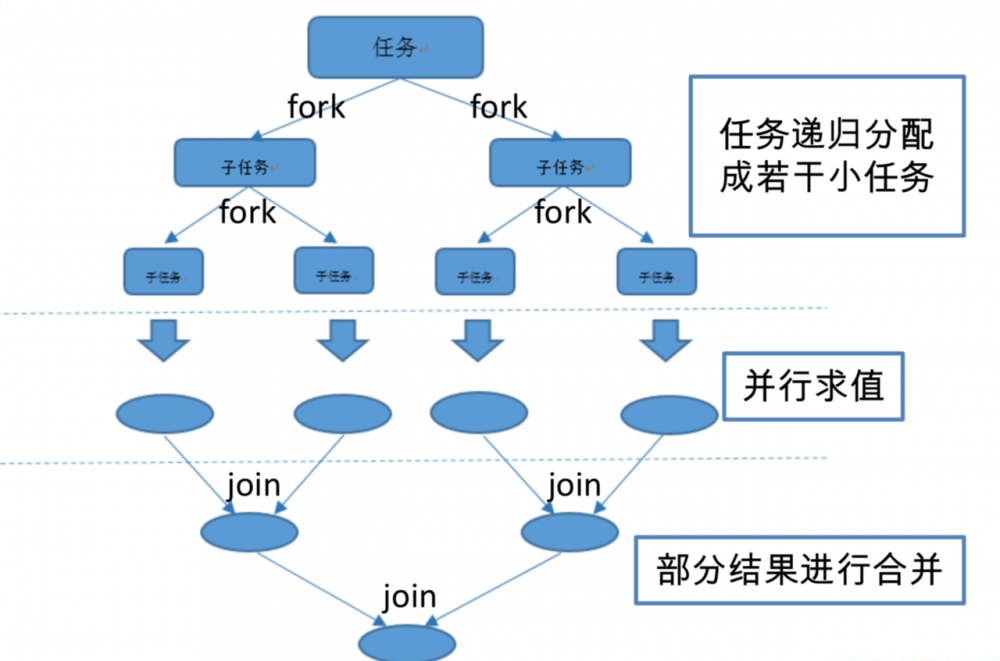
Fork/Join 框架与传统线程池的区别
采用 “工作窃取”模式(work-stealing): 当执行新的任务时它可以将其拆分,分成更小的任务执行,并将小任务加到线 程队列中,然后再从一个随机线程的队列中偷一个并把它放在自己的队列中。
相对于一般的线程池实现,fork/join框架的优势体现在对其中包含的任务的 处理方式上.在一般的线程池中,如果一个线程正在执行的任务由于某些原因 无法继续运行,那么该线程会处于等待状态。而在fork/join框架实现中,如果 某个子问题由于等待另外一个子问题的完成而无法继续运行,那么处理该子 问题的线程会主动寻找其他尚未运行的子问题来执行.这种方式减少了线程 的等待时间,提高了性能。
public class ForkJoinCalculate extends RecursiveTask<Long>{
private static final long serialVersionUID = -1L;
private long start;
private long end;
private static final long THRESHOLD = 10000L; //临界值
public ForkJoinCalculate(long start, long end) {
this.start = start;
this.end = end;
}
@Override
protected Long compute() {
long length = end - start;
if(length <= THRESHOLD){
long sum = 0;
for (long i = start; i <= end; i++) {
sum += i;
}
return sum;
}else{
long middle = (start + end) / 2;
ForkJoinCalculate left = new ForkJoinCalculate(start, middle);
left.fork(); //拆分,并将该子任务压入线程队列
ForkJoinCalculate right = new ForkJoinCalculate(middle+1, end);
right.fork();
return left.join() + right.join();
}
}
}
复制代码
public class TestForkJoin {
@Test
public void test1(){
long start = System.currentTimeMillis();
ForkJoinPool pool = new ForkJoinPool();
ForkJoinTask<Long> task = new ForkJoinCalculate(0L, 10000000000L);
long sum = pool.invoke(task);
System.out.println(sum);
long end = System.currentTimeMillis();
System.out.println("耗费的时间为: " + (end - start)); //112-1953-1988-2654-2647-20663-113808
}
@Test
public void test2(){
long start = System.currentTimeMillis();
long sum = 0L;
for (long i = 0L; i <= 10000000000L; i++) {
sum += i;
}
System.out.println(sum);
long end = System.currentTimeMillis();
System.out.println("耗费的时间为: " + (end - start)); //34-3174-3132-4227-4223-31583
}
@Test
public void test3(){
long start = System.currentTimeMillis();
Long sum = LongStream.rangeClosed(0L, 10000000000L)
.parallel()
.sum();
System.out.println(sum);
long end = System.currentTimeMillis();
System.out.println("耗费的时间为: " + (end - start)); //2061-2053-2086-18926
}
}
复制代码
Optional 类
Optional 类(java.util.Optional) 是一个容器类,代表一个值存在或不存在, 原来用 null 表示一个值不存在,现在 Optional 可以更好的表达这个概念。并且 可以避免空指针异常。
常用方法: Optional.of(T t) : 创建一个 Optional 实例
Optional.empty() : 创建一个空的 Optional 实例
Optional.ofNullable(T t):若 t 不为 null,创建 Optional 实例,否则创建空实例
isPresent() : 判断是否包含值
orElse(T t) : 如果调用对象包含值,返回该值,否则返回t
orElseGet(Supplier s) :如果调用对象包含值,返回该值,否则返回 s 获取的值
map(Function f): 如果有值对其处理,并返回处理后的Optional,否则返回 Optional.empty() flatMap(Function mapper):与 map 类似,要求返回值必须是Optional
public class Godness {
private String name;
public Godness() {
}
public Godness(String name) {
this.name = name;
}
public String getName() {
return name;
}
public void setName(String name) {
this.name = name;
}
@Override
public String toString() {
return "Godness [name=" + name + "]";
}
}
public class Man {
private Godness god;
public Man() {
}
public Man(Godness god) {
this.god = god;
}
public Godness getGod() {
return god;
}
public void setGod(Godness god) {
this.god = god;
}
@Override
public String toString() {
return "Man [god=" + god + "]";
}
}
//注意:Optional 不能被序列化
public class NewMan {
private Optional<Godness> godness = Optional.empty();
private Godness god;
public Optional<Godness> getGod(){
return Optional.of(god);
}
public NewMan() {
}
public NewMan(Optional<Godness> godness) {
this.godness = godness;
}
public Optional<Godness> getGodness() {
return godness;
}
public void setGodness(Optional<Godness> godness) {
this.godness = godness;
}
@Override
public String toString() {
return "NewMan [godness=" + godness + "]";
}
}
/*
* 一、Optional 容器类:用于尽量避免空指针异常
* Optional.of(T t) : 创建一个 Optional 实例
* Optional.empty() : 创建一个空的 Optional 实例
* Optional.ofNullable(T t):若 t 不为 null,创建 Optional 实例,否则创建空实例
* isPresent() : 判断是否包含值
* orElse(T t) : 如果调用对象包含值,返回该值,否则返回t
* orElseGet(Supplier s) :如果调用对象包含值,返回该值,否则返回 s 获取的值
* map(Function f): 如果有值对其处理,并返回处理后的Optional,否则返回 Optional.empty()
* flatMap(Function mapper):与 map 类似,要求返回值必须是Optional
*/
public class TestOptional {
@Test
public void test4(){
Optional<Employee> op = Optional.of(new Employee(101, "张三", 18, 9999.99));
Optional<String> op2 = op.map(Employee::getName);
System.out.println(op2.get());
Optional<String> op3 = op.flatMap((e) -> Optional.of(e.getName()));
System.out.println(op3.get());
}
@Test
public void test3(){
Optional<Employee> op = Optional.ofNullable(new Employee());
if(op.isPresent()){
System.out.println(op.get());
}
Employee emp = op.orElse(new Employee("张三"));
System.out.println(emp);
Employee emp2 = op.orElseGet(() -> new Employee());
System.out.println(emp2);
}
@Test
public void test2(){
/*Optional<Employee> op = Optional.ofNullable(null);
System.out.println(op.get());*/
// Optional<Employee> op = Optional.empty();
// System.out.println(op.get());
}
@Test
public void test1(){
Optional<Employee> op = Optional.of(new Employee());
Employee emp = op.get();
System.out.println(emp);
}
@Test
public void test5(){
Man man = new Man();
String name = getGodnessName(man);
System.out.println(name);
}
//需求:获取一个男人心中女神的名字
public String getGodnessName(Man man){
if(man != null){
Godness g = man.getGod();
if(g != null){
return g.getName();
}
}
return "苍老师";
}
//运用 Optional 的实体类
@Test
public void test6(){
Optional<Godness> godness = Optional.ofNullable(new Godness("林志玲"));
Optional<NewMan> op = Optional.ofNullable(new NewMan(godness));
String name = getGodnessName2(op);
System.out.println(name);
}
public String getGodnessName2(Optional<NewMan> man){
return man.orElse(new NewMan())
.getGodness()
.orElse(new Godness("苍老师"))
.getName();
}
}
复制代码
接口中的默认方法与静态方法
默认方法
Java 8中允许接口中包含具有具体实现的方法,该方法称为 “默认方法”,默认方法使用 default 关键字修饰。
接口默认方法的”类优先”原则 若一个接口中定义了一个默认方法,而另外一个父类或接口中 又定义了一个同名的方法时
- 选择父类中的方法。如果一个父类提供了具体的实现,那么 接口中具有相同名称和参数的默认方法会被忽略。
- 接口冲突。如果一个父接口提供一个默认方法,而另一个接 口也提供了一个具有相同名称和参数列表的方法(不管方法 是否是默认方法),那么必须覆盖该方法来解决冲突
静态方法
Java8 中,接口中允许添加静态方法。
public interface MyInterface1 {
default String getName(){
return "哈哈哈";
}
}
public interface MyInterface2 {
default String getName(){
return "呵呵呵";
}
public static void show(){
System.out.println("接口中的静态方法");
}
}
public class MyClass {
public String getName(){
return "嘿嘿嘿";
}
}
public class SubClass /*extends MyClass*/ implements MyFun, MyInterface{
@Override
public String getName() {
return MyInterface.super.getName();
}
}
public class TestDefaultInterface {
public static void main(String[] args) {
SubClass sc = new SubClass();
System.out.println(sc.getName());
MyInterface.show();
}
}
复制代码
新的时间日期API
使用 LocalDate、LocalTime、LocalDateTime
LocalDate、LocalTime、LocalDateTime 类的实 例是不可变的对象,分别表示使用 ISO-8601日 历系统的日期、时间、日期和时间。它们提供 了简单的日期或时间,并不包含当前的时间信 息。也不包含与时区相关的信息。
注:ISO-8601日历系统是国际标准化组织制定的现代公民的日期和时间的表示法
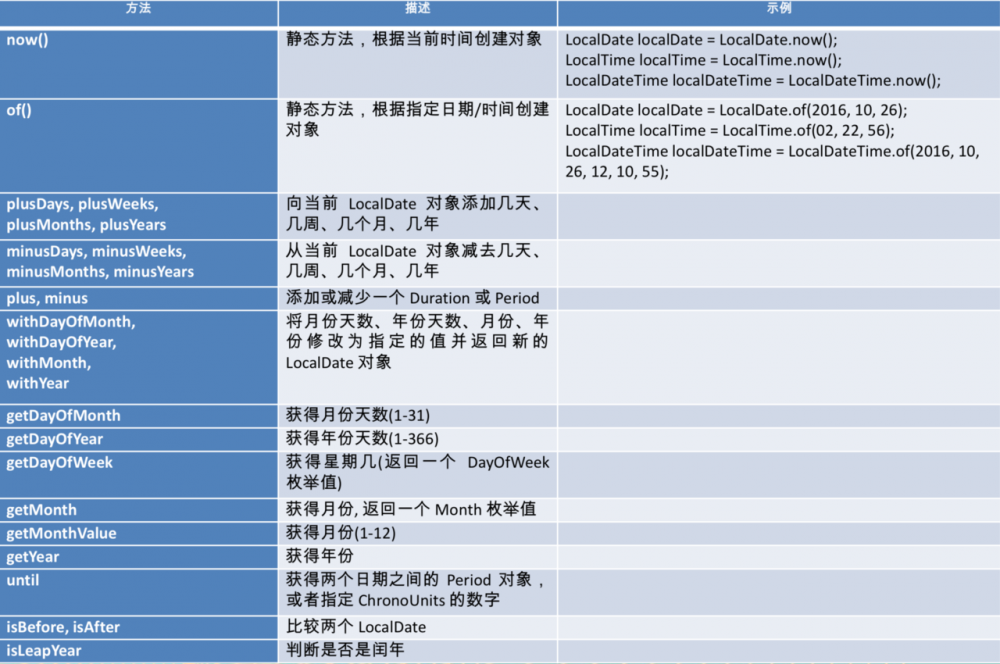
Instant 时间戳
用于“时间戳”的运算。它是以Unix元年(传统 的设定为UTC时区1970年1月1日午夜时分)开始 所经历的描述进行运算
Duration 和 Period
- Duration:用于计算两个“时间”间隔
- Period:用于计算两个“日期”间隔
日期的操纵
- TemporalAdjuster : 时间校正器。有时我们可能需要获 取例如:将日期调整到“下个周日”等操作。
- TemporalAdjusters : 该类通过静态方法提供了大量的常 用 TemporalAdjuster 的实现。

解析与格式化
java.time.format.DateTimeFormatter 类:该类提供了三种 格式化方法:
- 预定义的标准格式
- 语言环境相关的格式
- 自定义的格式
时区的处理
Java8 中加入了对时区的支持,带时区的时间为分别为: ZonedDate、ZonedTime、ZonedDateTime 其中每个时区都对应着 ID,地区ID都为 “{区域}/{城市}”的格式 例如 :Asia/Shanghai 等
ZoneId:该类中包含了所有的时区信息 getAvailableZoneIds() : 可以获取所有时区时区信息 of(id) : 用指定的时区信息获取 ZoneId 对象
与传统日期处理的转换
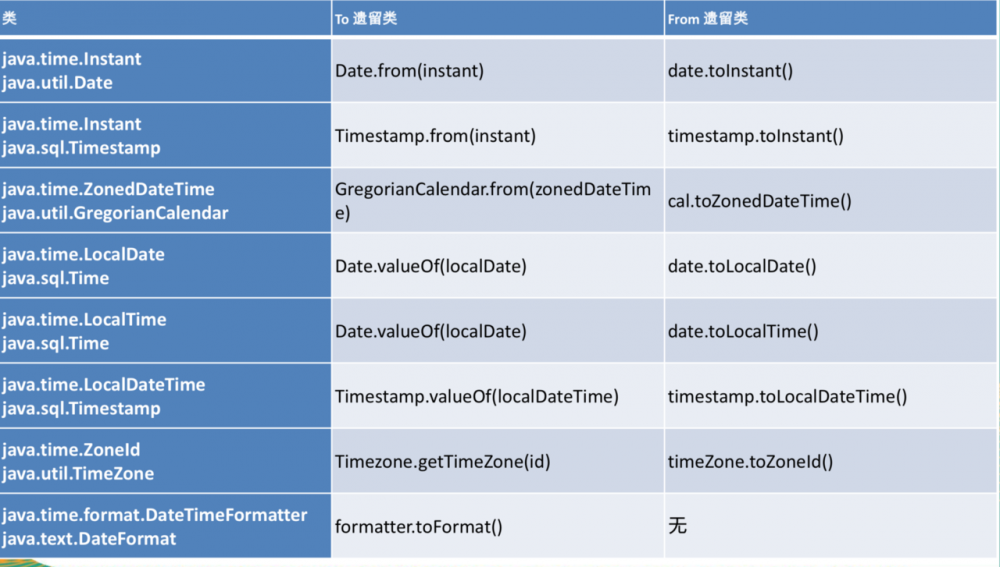
public class DateFormatThreadLocal {
private static final ThreadLocal<DateFormat> df = new ThreadLocal<DateFormat>(){
protected DateFormat initialValue(){
return new SimpleDateFormat("yyyyMMdd");
}
};
public static final Date convert(String source) throws ParseException{
return df.get().parse(source);
}
}
public class TestSimpleDateFormat {
public static void main(String[] args) throws Exception {
/*SimpleDateFormat sdf = new SimpleDateFormat("yyyyMMdd");
Callable<Date> task = new Callable<Date>() {
@Override
public Date call() throws Exception {
return sdf.parse("20161121");
}
};
ExecutorService pool = Executors.newFixedThreadPool(10);
List<Future<Date>> results = new ArrayList<>();
for (int i = 0; i < 10; i++) {
results.add(pool.submit(task));
}
for (Future<Date> future : results) {
System.out.println(future.get());
}
pool.shutdown();*/
//解决多线程安全问题
/*Callable<Date> task = new Callable<Date>() {
@Override
public Date call() throws Exception {
return DateFormatThreadLocal.convert("20161121");
}
};
ExecutorService pool = Executors.newFixedThreadPool(10);
List<Future<Date>> results = new ArrayList<>();
for (int i = 0; i < 10; i++) {
results.add(pool.submit(task));
}
for (Future<Date> future : results) {
System.out.println(future.get());
}
pool.shutdown();*/
DateTimeFormatter dtf = DateTimeFormatter.ofPattern("yyyyMMdd");
Callable<LocalDate> task = new Callable<LocalDate>() {
@Override
public LocalDate call() throws Exception {
LocalDate ld = LocalDate.parse("20161121", dtf);
return ld;
}
};
ExecutorService pool = Executors.newFixedThreadPool(10);
List<Future<LocalDate>> results = new ArrayList<>();
for (int i = 0; i < 10; i++) {
results.add(pool.submit(task));
}
for (Future<LocalDate> future : results) {
System.out.println(future.get());
}
pool.shutdown();
}
}
public class TestLocalDateTime {
//6.ZonedDate、ZonedTime、ZonedDateTime : 带时区的时间或日期
@Test
public void test7(){
LocalDateTime ldt = LocalDateTime.now(ZoneId.of("Asia/Shanghai"));
System.out.println(ldt);
ZonedDateTime zdt = ZonedDateTime.now(ZoneId.of("US/Pacific"));
System.out.println(zdt);
}
@Test
public void test6(){
Set<String> set = ZoneId.getAvailableZoneIds();
set.forEach(System.out::println);
}
//5. DateTimeFormatter : 解析和格式化日期或时间
@Test
public void test5(){
// DateTimeFormatter dtf = DateTimeFormatter.ISO_LOCAL_DATE;
DateTimeFormatter dtf = DateTimeFormatter.ofPattern("yyyy年MM月dd日 HH:mm:ss E");
LocalDateTime ldt = LocalDateTime.now();
String strDate = ldt.format(dtf);
System.out.println(strDate);
LocalDateTime newLdt = ldt.parse(strDate, dtf);
System.out.println(newLdt);
}
//4. TemporalAdjuster : 时间校正器
@Test
public void test4(){
LocalDateTime ldt = LocalDateTime.now();
System.out.println(ldt);
LocalDateTime ldt2 = ldt.withDayOfMonth(10);
System.out.println(ldt2);
LocalDateTime ldt3 = ldt.with(TemporalAdjusters.next(DayOfWeek.SUNDAY));
System.out.println(ldt3);
//自定义:下一个工作日
LocalDateTime ldt5 = ldt.with((l) -> {
LocalDateTime ldt4 = (LocalDateTime) l;
DayOfWeek dow = ldt4.getDayOfWeek();
if(dow.equals(DayOfWeek.FRIDAY)){
return ldt4.plusDays(3);
}else if(dow.equals(DayOfWeek.SATURDAY)){
return ldt4.plusDays(2);
}else{
return ldt4.plusDays(1);
}
});
System.out.println(ldt5);
}
//3.
//Duration : 用于计算两个“时间”间隔
//Period : 用于计算两个“日期”间隔
@Test
public void test3(){
Instant ins1 = Instant.now();
System.out.println("--------------------");
try {
Thread.sleep(1000);
} catch (InterruptedException e) {
}
Instant ins2 = Instant.now();
System.out.println("所耗费时间为:" + Duration.between(ins1, ins2));
System.out.println("----------------------------------");
LocalDate ld1 = LocalDate.now();
LocalDate ld2 = LocalDate.of(2011, 1, 1);
Period pe = Period.between(ld2, ld1);
System.out.println(pe.getYears());
System.out.println(pe.getMonths());
System.out.println(pe.getDays());
}
//2. Instant : 时间戳。 (使用 Unix 元年 1970年1月1日 00:00:00 所经历的毫秒值)
@Test
public void test2(){
Instant ins = Instant.now(); //默认使用 UTC 时区
System.out.println(ins);
OffsetDateTime odt = ins.atOffset(ZoneOffset.ofHours(8));
System.out.println(odt);
System.out.println(ins.getNano());
Instant ins2 = Instant.ofEpochSecond(5);
System.out.println(ins2);
}
//1. LocalDate、LocalTime、LocalDateTime
@Test
public void test1(){
LocalDateTime ldt = LocalDateTime.now();
System.out.println(ldt);
LocalDateTime ld2 = LocalDateTime.of(2016, 11, 21, 10, 10, 10);
System.out.println(ld2);
LocalDateTime ldt3 = ld2.plusYears(20);
System.out.println(ldt3);
LocalDateTime ldt4 = ld2.minusMonths(2);
System.out.println(ldt4);
System.out.println(ldt.getYear());
System.out.println(ldt.getMonthValue());
System.out.println(ldt.getDayOfMonth());
System.out.println(ldt.getHour());
System.out.println(ldt.getMinute());
System.out.println(ldt.getSecond());
}
}
复制代码
重复注解与类型注解
Java 8对注解处理提供了两点改进:可重复的注解及可用于类 型的注解。
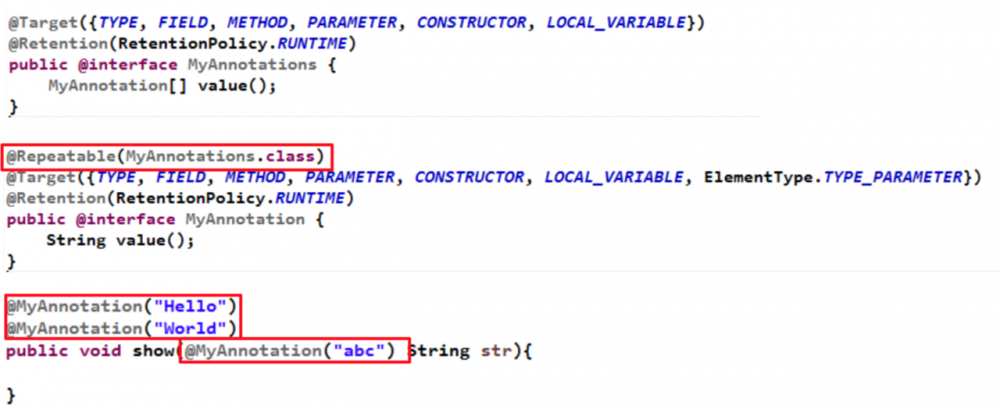
@Target({TYPE, FIELD, METHOD, PARAMETER, CONSTRUCTOR, LOCAL_VARIABLE})//可以修饰的目标
@Retention(RetentionPolicy.RUNTIME)//生命周期
public @interface MyAnnotations {
MyAnnotation[] value();
}
@Repeatable(MyAnnotations.class)
@Target({TYPE, FIELD, METHOD, PARAMETER, CONSTRUCTOR, LOCAL_VARIABLE,TYPE_PARAMETER})//可以修饰的目标
@Retention(RetentionPolicy.RUNTIME)//生命周期
public @interface MyAnnotation {
String value() default "hello Annotation";
}
public class TestAnnotation {
//checker framework框架提供此注解
private /*@NonNull*/ Object obj=null;
@Test
public void test1() throws NoSuchMethodException, SecurityException{
Class<TestAnnotation> clazz=TestAnnotation.class;
Method m1=clazz.getMethod("show");
MyAnnotation[] mas=m1.getAnnotationsByType(MyAnnotation.class);
for(MyAnnotation myAnnotation:mas){
System.out.println(myAnnotation.value());
}
}
@MyAnnotation("Hello")
@MyAnnotation("world")
public void show(@MyAnnotation("abc")String str){
}
}
复制代码
- 本文标签: ORM 多线程 ArrayList java parse consumer UTC ACE UI Collection 时间 限流 unix list entity 线程 Service API HashMap 解析 final tag https 生命 map IO 需求 静态方法 测试 value src 数据库 Action NSA bus App HashSet struct 返回值类型 http sql executor 代码 JVM 定制 实例 dist find Security IDE id CTO stream ip 参数 ask 安全 mapper Google equals 编译 DOM 工资 rand tar 线程池 数据 希望 设计模式 lambda tab 组织 DDL cat
- 版权声明: 本文为互联网转载文章,出处已在文章中说明(部分除外)。如果侵权,请联系本站长删除,谢谢。
- 本文海报: 生成海报一 生成海报二











![[HBLOG]公众号](https://www.liuhaihua.cn/img/qrcode_gzh.jpg)

